Fields, Clouds and Blue Sky
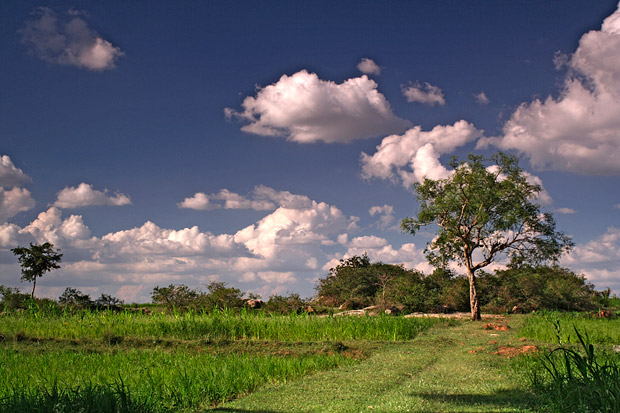

I spent the September busy, if not pretending to be busy. To tell you the truth, all I did was to travel and muse about travel. A trip to Shimla kept me in in a mood for mountains for a long time, when all I did was to let my thoughts linger there. As they often say these days, I needed another holiday to get over the holiday mood.
This time the destination was the hills of Mullayyanagiri bordering the Bhadra Wildlife Sanctuary. It was going to be an inactive holiday – no intensive travel, no exploring, no photography. No activity, that’s all!
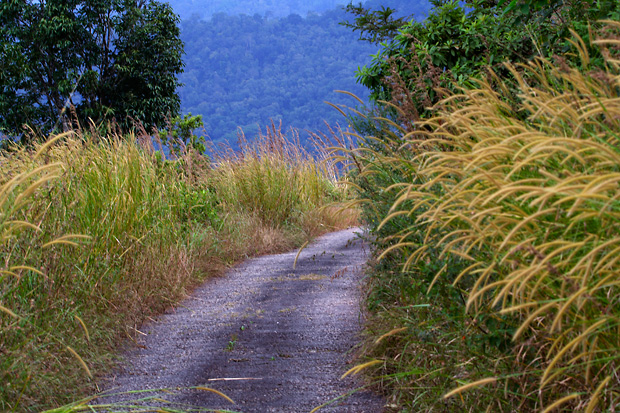
A file photo of a road near Mullayyanagiri
We had left Bangalore on a rainy afternoon and arrived at Chikmagalur at 11pm – a little later than we would have liked to. It was still drizzling as we got into the rugged jeep that took us deeper into the hills. We drove on a wet and misty road towards the hills of Mullayyanagiri with no thoughts in the mind but to quickly reach the destination and retire for the day. I would have liked it if we were on this road during the day, when one could see the lush grass on the slopes, and when weather permits, rolling hills or the plains of Chikmagalur. But not to feel bad, we were to spend two days in a coffee estate nestled in the depth of these hills.
With us in the jeep was Prasad, the cheerful driver and the estate manager Cariappa. Cariappa kept to himself first but quickly got talking when Prasad started a conversation.
‘I have been managing the plantations here for 33 years now. There are multiple estates spread in different locations around Chikmagalur…
‘I am from Ammathi at Coorg. I would like to go back to Coorg now but they would not let me..’
‘We always used to spot some or the other wild animals on the way to the estate. There was nothing today, not even a deer or boar..’
We reached the estate exactly at midnight. Having arrived in the dark, I had no clue about the location and setting of the estate. It wasn’t much different next morning either, when I woke up to see a thick fog blocking my views. But with whatever little I could see through the fog once in a while, it did seem like a beautiful place. Occasional holes in the blanket of moving fog revealed me a hill covered with thick tropical vegetation at its base and a silver-oak plantation near its grassy ridge. It seemed like there was a valley far below hidden in the fog that I would never get to see in the days I was to spend there.
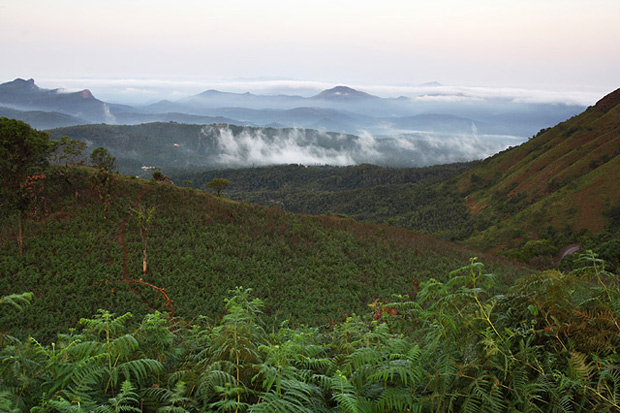
A file photo of hills near Mullayyanagiri
Within my views were the coffee plants spread on the slopes, a few buildings within the coffee estate and the dirt roads that crisscrossed the area. A silhouette of tall Silver Oaks stood parallel to each other in the fog. The trees in the estate looked wet, fresh and green, washed by three months of monsoons. The place looked mysteriously beautiful in the foggy weather, but left me in anticipation of seeing the landscape behind the depth of the fog.
Sitting back on my chair in the balcony with a book in my hand that morning, I watched the wind carry the clouds away and bringing in a fresh lot every now and then. The day was just unfolding for me, and also for the birds in the forest. I excitedly watched a barbet land on a tree very close to where I sat. A grey wagtail came closer and landed on the roof before it saw me and flew away. Malabar Parakeets made long distance flights between gaps in the canopy, squeaking loudly in flight. Red Whiskered Bulbuls inspected the nearby bushes, probably in search of worms. I watched them all, drowning cup after cup of hot filter coffee that compensated for the cold mountain breeze, occasionally glancing at my book when the outside world fell silent.
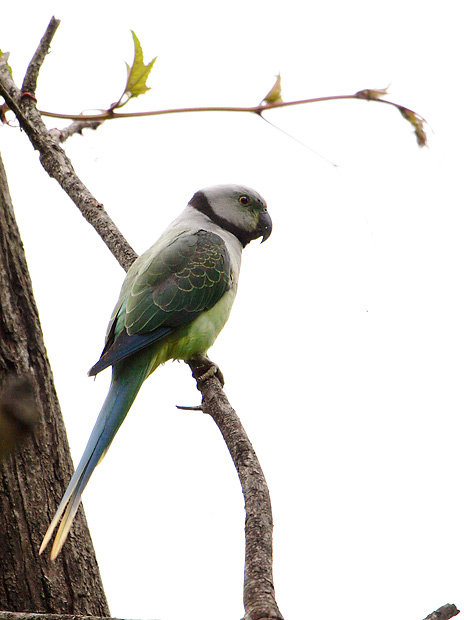
File photo of a Malabar Parakeet in Bhadra Wilderness
On a long walk past the estate later in the day, the magic of the monsoon unfolded in the slopes of the coffee country. I saw along my way, a bell-shaped purple flower with tiny water droplets on its petals that kept it fresh and beautiful. As I bent down to take a closer look, a tiny insect walked out from the heart of the flower, having had a stomach full of nectar. I peeped in closer to see two more of its kins busy feeding. A little later, I found a bee-like insect hovering over small yellow flowers, sucking the juice with ease with its long and sharp suction pipe located on its nose, which allowed it to easily delve deeper into the flower. Big butterflies of all colours hovered on the blooming flowers – one with a greenish wing with a strip of bright white, another with dark wings with a sparkling blue patch and another one bight yellow.
Up on the trees with their barks crowded with lichens, birds fluttered and sang happily. I saw a scarlet minivet that stood out in the greenery with its crimson plumage, a bunch of babblers, a flock of white-eyes and a large number of bulbuls. A hawk cuckoo sat graciously on a branch and inspected its surroundings. On a sharp curve along a steep slope where the trees were spread thinly to keep the coffee in shade, the mid-day symphony of the cicadas amplified into an almost ear-piercing clamour. Streams emerged from the slopes, appearing pristine but probably laden with pesticides from the coffee plantations sprayed before the monsoons. Fog disappeared slowly with progress of the day, revealing smooth grass laden slopes above the treeline.
A let up in the fog reveled the valley of Bhadra later in the day. In the view was thick uninterrupted greenery covered the wide basin of the valley, with hills rising again at the far end. Reflection from the waters of Bhadra Reservoir sparkled brightly near the horizon. Fog played with the scenery like a curtain raising and falling, sometimes letting in just a glimpse of the wide expanse of the vista.
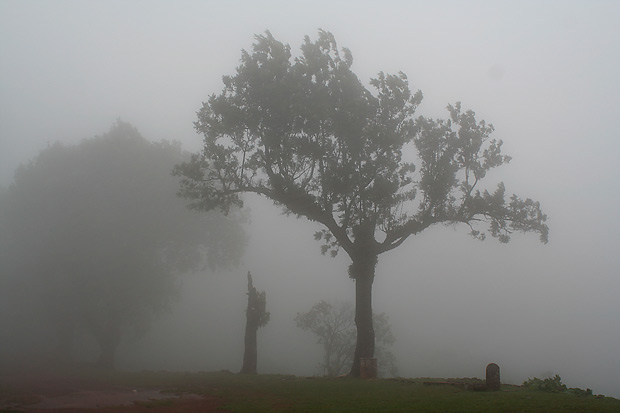
File photo – A foggy day near Mullayyanagiri
Later in the day, I spoke to Aravaind, the estate owner and former forest ranger, about the conservation efforts in Bhadra Wildlife Sanctuary. The reserve makes a good examples of rehabilitating people who once lived in the park and depended partially on the forest for livelihood. When the sanctuary was notified, the villagers in the forest were efficiently rehabilitated and every family was given arable land elsewhere in the district.
‘Some villages were deep in the forest. They had to walk for two hours to get to the nearest shop,’ Aravind told me, ‘so if they want to have some chicken for dinner, it would have been easy to go search for some fowl in the jungle than walk for four long hours.’
I have seen some results of the rehabilitation myself. In places where they had paddy fields before people moved out, you now see a bunch of bisons carelessly feasting on wild grass. Spread across an area of nearly 2,000 km², Bhadra is a tiger reserve with thick tropical forest and a population of more than 30 tigers (according 1997 census. See project tiger website). The trees here are tall and the canopy so thick, once traversing in this forest, I heard bird calls all along the way from the treetop, but never once managing to spot the origin of these sounds.
Spending another day in the foggy but pleasing weather, we drove back to Chikmagalur next day, again in darkness, again wishing that we had driven during the day.
This is a guest post from Lakshmi Sharath, a travel writer who has been researching on the Hoysala Dynasty for some time now. Lakshmi blogs at backpakker. Stay tuned to this page to know more on the Hoysala dynasty. Text and photographs by Lakshmi.
The meandering roads snaked around a green fabric of coffee plantations and dense forests. The leaves of the pepper crops curled around the silver oak trees. It had rained a bit but the afternoon sun was now shining in all its glory. The snowy white blossoms of the coffee plants glistened even further . The dusty hamlets interrupted this green mosaic as they emerged one after another . It was late afternoon and the roads were empty .
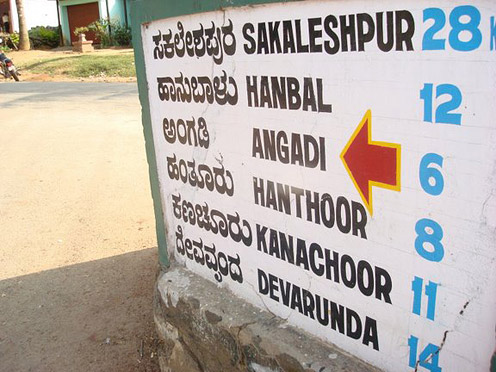
We were in Malenadu or the hilly regions of Karnataka looking for a humble beginning of a dynasty which had ruled this region more than thousand years ago. This was not a pleasure trip, but a journey that took us down eons of history , a quest in search of folklores and myths that gave an identity to the Hoysala Dynasty .Our destination was Angadi, a small hamlet lost in the hills of Karnataka, enveloped by coffee plantations and lush green fields. Nestled in the Western Ghats, in South India in the heart of coffee country, this nondescript village was once the birthplace of a powerful dynasty which ruled South India thousands of years ago.
We stopped by at a small town, Janapura to have some tea and take in the fresh air. The directions were loud and clear. Angadi was a further seven kms away. In about ten minutes we were there. A small village with a few houses scattered here and there , a couple of shops, a lone bus stand and green fields. At first glance, it looked like just another hamlet lost to the world. And yet, it was the cradle of a dynasty that built beautiful temples and made several conquests . However to our eyes, there was nothing historic about it. And then we took a short stroll, wondering if we had indeed come to the right village. To prove us right, stood a faded old relic under the shade of a tree ..a Hoysala inscription . We were indeed on the right track.
Angadi in Kannada means shop, but we hardly found any shops around . Surrounded by coffee plantations and open fields, it seemed to be a sleepy market . We finally found a small shop and asked them the route to the “ Devasthanam “ meaning temple in the local lingo. A couple of hands pointed uphill which took us through a coffee plantation which led to mud roads which split into two. There was not a soul around. We followed the road going upward and encountered steep hairpin bends which curved through the coffee plantations and led us to the Durga or the Vasantha Parameshwari temple . And this was the setting of the origins of the Dynasty. It took us to a scene enacted thousand years ago.
The origin of Hoysalas
Hoy Sala ” ( Strike Sala ! ) said the guru Sudatta Muni to his student , Sala who was in an armed combat with a tiger . The beast had just attached the duo who were immersed in rituals at a Durga or Vasantha Parameshwari temple in a village called Sasakapura or Sosevur. The student struck the animal in one blow, immortalizing himself and his victim . The guru was so pleased that he asked Sala to establish a kingdom and the Hoysala dynasty was established with Sosevur as the capital . The folklore became so popular that every temple of the Hoysalas has this story carved in stone and it became the royal emblem of the dynasty.
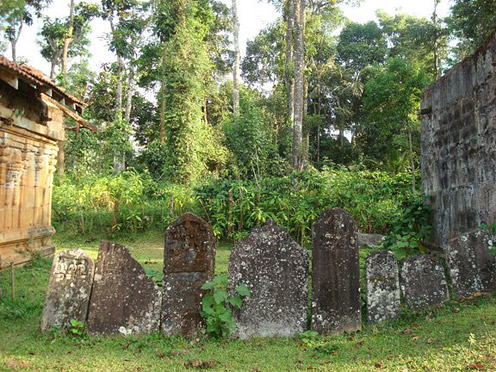
Historians however attribute the sculpture to the victory of the Hoysalas over the Cholas by Vishnuvardhan, one of the Hoysala rulers . The tiger, being a symbol of the Cholas is shown subdued by a soldier. The incident , nevertheless is believed to have happenned at Sasakapura or Sosevur which is today identified as Angadi, a small hamlet in Chikmagalur district in Karnataka. The temple of the Goddess , along with the ruins of more temples and basadis is the only proof of this myth .
The Hoysalas were not born kings but they ruled for 300 years . They were natives of Malnad, Karnataka and were tribal chiefs who were subordinates of the Western Chalukyas. Some inscriptions show them as lords of the Male (hills) while some indicate that they were descendants of the Yadava clan. Historically though the first Hoysala family record is dated 950 and names Arekalla as the chieftain, followed by Maruga and Nripa Kama I (976) .
But the kings who shaped the dynasties were Vishnuvardhan and Veera Bhallalla who became independent from the Chalukyas . They are remembered today for their patronage to arts along with their exploits on the battlefield – a baffling 1500 temples built in 958 centres, of which the two famous ones are Belur and Halebid which were the capital cities of the dynasty. However, hardly a 100 survive today. Our trail had taken us down to 25 villages including Angadi , the original capital of the empire, where it all began.
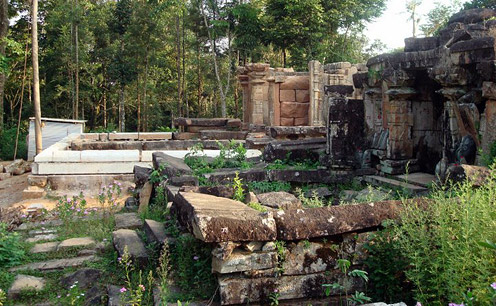
The Durga temple was renovated and was well maintained . It did not look like a typical Hoysala temple either , going by their style . A tall structure supported by pillars with sculptures stood close by. The priest explained to us that the temple, which has been renovated recently was the original temple where Sala had killed the legendary tiger. The pillars he said were used as a swing to cradle the Gods during festivals. I had read that there was the ruins of a Chennakesava temple here similar to the Belur temple . We asked him where the ruins were and he told us to follow the roads that went below. We were told that there were three temples as well as basadis .
The ruins of Angadi
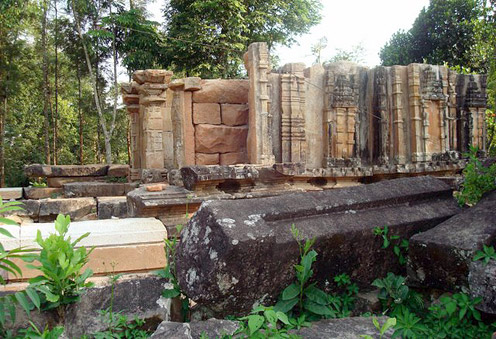
The priest guided us and we followed the road below until we came to almost a deadend. There seemed to be a rugged path above as we climbed on the rocks that led us inside the coffee plantation. We saw a few basadis with some sculptures inside while a few were left wide in the open. It was silent except for some parakeets which were shrieking in excitement. We almost thought the place was to ourselves when we heard some voices . We squinted through the trees and found some workers. We went down and climbed another path where the ruins of the three temples awaited us . The Chennakesava temple , along with Patalarudreshwara and Mallikarjuna lay absolutely in ruins..The structures were being laid by the ASI workers who had just begun restoring these temples. The idols and sculptures were kept safely, especially the Chennakesava which stood in all its glory in the glare of the setting sun. As the sun touched down, we sat a while on the broken pillars gazing at the strewn idols and wondering about the times when a dynasty was laying its foundation stone in a small village. It dawned on us at that very moment, that we had just walked into a historic moment.
Powered by sciolism 2019 and WordPress.